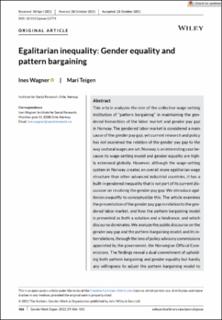| dc.contributor.author | Wagner, Ines | |
| dc.contributor.author | Teigen, Mari | |
| dc.date.accessioned | 2022-03-08T06:51:50Z | |
| dc.date.available | 2022-03-08T06:51:50Z | |
| dc.date.created | 2021-11-25T18:12:40Z | |
| dc.date.issued | 2021 | |
| dc.identifier.citation | Gender, Work & Organization. 2021, 29 486-501. | |
| dc.identifier.issn | 0968-6673 | |
| dc.identifier.uri | https://hdl.handle.net/11250/2983594 | |
| dc.description.abstract | This article analyzes the role of the collective wage-setting institution of “pattern bargaining” in maintaining the gendered hierarchies of the labor market and gender pay gap in Norway. The gendered labor market is considered a main cause of the gender pay gap, yet current research and policy has not examined the relation of the gender pay gap to the way sectoral wages are set. Norway is an interesting case because its wage-setting model and gender equality are highly esteemed globally. However, although the wage-setting system in Norway creates an overall more egalitarian wage structure than other advanced industrial countries, it has a built-in gendered inequality that is not part of its current discussion on resolving the gender pay gap. We introduce egalitarian inequality to conceptualize this. The article examines the presentation of the gender pay gap in relation to the gendered labor market, and how the pattern bargaining model is presented as both a solution and a hindrance, and which discourse dominates. We analyze the public discourse on the gender pay gap and the pattern-bargaining model, and its interrelations, through the lens of policy advisory commissions appointed by the government, the Norwegian Official Commissions. The findings reveal a dual commitment of upholding both pattern bargaining and gender equality but hardly any willingness to adjust the pattern bargaining model to combat the gender pay gap. A clear hierarchy is expressed in which gender equality is subordinate to pattern bargaining. | |
| dc.language.iso | eng | |
| dc.title | Egalitarian inequality: Gender equality and pattern bargaining | |
| dc.type | Peer reviewed | |
| dc.type | Journal article | |
| dc.description.version | publishedVersion | |
| dc.source.pagenumber | 486-501 | |
| dc.source.volume | 29 | |
| dc.source.journal | Gender, Work & Organization | |
| dc.identifier.doi | 10.1111/gwao.12774 | |
| dc.identifier.cristin | 1959347 | |
| dc.relation.project | Kulturdepartementet: CORE | |
| dc.relation.project | Senter for grunnforskning: GOODPOL | |
| cristin.ispublished | true | |
| cristin.fulltext | original | |
| cristin.qualitycode | 2 | |
